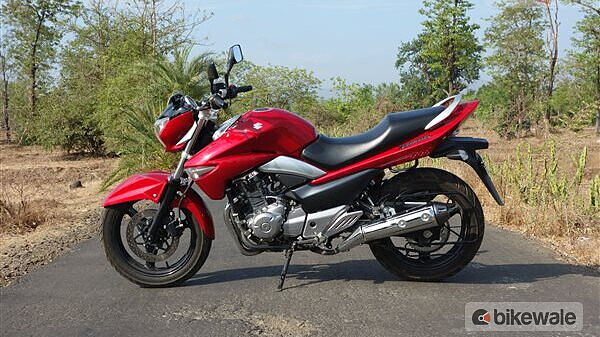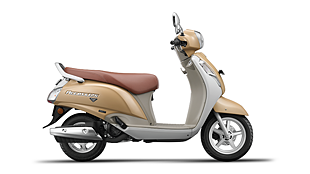Introduction

We are the world’s largest motorcycle market, but in those numbers hides a disappointing fact: most of the two-wheelers that go on sale are clones of each other. Of course, this is driven by the market’s need, and the market is driven by need alone. We want fuel efficient motorcycles that are inexpensive, both to buy and run, can carry two hundred-kilo riders, and maybe a sack of potatoes or five milk cans, depending on the requirement. Motorcycling as a leisure activity has not really entered the mass-market’s consciousness, so when a motorcycle like the Inazuma is launched, the first question that comes to mind isn’t “Is this motorcycle ready for India?” but instead, “Is India ready for this motorcycle?”
Looks

Dead on, the Inazuma looks a little odd because of the narrow headlamp followed by the broad ‘shoulders’ of the tank on either side. This improves ever so slightly when you move to the front three-quarter angle, because of the big tank extensions on either side that lend muscle to the design. That bulbous headlamp lens stays true to its B-King origins, but it looks just a wee bit ungainly on the Inazuma. Move to the side, and the motorcycle becomes both interesting and ungainly. It looks large, and the many parallel lines that rise towards the rear like the crease on the front mudguard, headlamp fairing, the tank extensions, the side panels and the twin exhausts look very nice. Another neat parallel element is the triple “shark gill” slots in the footpegs’ vertical protectors, and under the ‘Inazuma’ sticker on the side panels. The length of the front mudguard is simply too much to be stylish, the tank extensions dwarf the tank itself, and the single-piece seat all lower the Inazuma’s appeal. However, the saree guard is very well integrated, and I do so love the three-spoke wheels and pentacle front disc brake mount. The quality of materials, fit and finish on the Inazuma is impeccable and will last as long as the best. There is attention to detail here: the rear footpegs are the same as the front, meaning the pillion has been given just as much thought as the rider, and for those who like to ride in the monsoon or off-road, the Inazuma’s disproportionate front mudguard will leave you perpetually smiling because it never lets any stones hit the radiator. This makes it the only import to have such a great quality.

The rear three-quarter angle is the best angle to view the Inazuma from. It shows off the rear tyre, the wide seat and rear panels, and the twin exhausts. The seat and panels are so wide, they make the 130mm wide rear tyre look narrow from right behind the motorcycle. The rear indicators aren’t the standard symmetric fare, either, with their top edges parallel to the ground.

Those looking for flash will rue the lack of projector lighting, daytime running lamps and an LED tail-lamp, but will certainly be impressed by the size of the Inazuma and the twin exhausts. There are only two colours to choose from – the deep metallic red you see in the photos, and one in all black. Suzuki hasn’t yet brought the special edition paint schemes to our market – they really should, they make the Inazuma look a lot more fetching. Suzuki has erred on the side of caution with this motorcycle, and although it does make the Inazuma fit in its own niche, at least here, for the price it needs more aggressive styling to attract attention.
Instrumentation & Ergonomics

Those of you who have seen a GS150R will find the Inazuma’s instrument cluster familiar. It is dominated by a central tachometer that contains a shift light and gear indicator. To the left are the warning and indicator lamps, and to the right is a digital display that houses the speedo, fuel gauge, clock, odometer and dual trip meters. The turn indicators are at the top of the two side pods, and at the bottom is the button that can be used to reset the trip meters and set the clock. The layout is simple, effective and clear both during the day and with its white backlighting at night.

The switchgear oozes quality, but surprisingly, it follows a very Indian-market feature of a headlamp on/off switch. The brake lever is adjustable for reach. The entire seat comes off, offering access to the tool kit, medical kit, battery and rear shock absorber adjustment. The gearshift lever is a toe-only shifter.

The Inazuma may not look like much, but it is a deceptively large motorcycle compared to the usual Indian motorcycle. Six-footers will be comfortable enough but people less than 5’10” will find that they have to stretch out to reach all the controls. The Inazuma doesn’t make the rider sit upright, but leans him forward just a little, much like the Honda CBR250R and Hero Karizma. The footpegs are slightly rearset, which helps control. The surprise element, though, is the rear seat. We’re so used to imported motorcycles making the pillion an afterthought, it is practically a shock to see one that gives equal importance to the person behind the rider. The Inazuma pillion has enough seat width and length to be comfortable all day. The footpegs are low enough to avoid a sitting-on-your-haunches position, and that massive grabrail also provides lower back support. If you’re planning two-up touring on a budget, the Inazuma’s seating position is the best on offer.
Engine & Performance

The Inazuma 250 is powered by a parallel twin 248cc engine that develops 24bhp and 22Nm of torque. It follows a similar layout and firing order as Kawasaki’s Ninja 250/300, but unlike the latter, the emphasis is on torque rather than power. It revs cleanly to its 11,000rpm redline, but it feels like a twin-cylinder CBR250R in the way that power is delivered: it is a strong wave of torque that starts low in the rev range and goes right up to the redline. It is one of the few motorcycles that doesn’t get fazed by two heavyweights – Pratheek and I put together exceed the load limit of any two wheeler, and yet the Inazuma quietly did its job, with only slightly blunted throttle response when the pillion was added. With two normal-sized riders, the difference will be negligible. The engine is free of harsh vibrations or any buzzing, but it is too muted for the average Joe. Unfortunately, changing the exhausts to make it louder will be an expensive affair – there are two end cans to replace here. However, this is only a bad thing if you’re an attention-seeker. Tourers will be happy with the quietness of the engine. The gearbox, as with all Suzuki gearboxes, is smooth, light and positive.
The Inazuma will not win any drag races, but if you’re looking for a CBR250R with more refinement (yes, more than a Honda!) the Inazuma is where you’ll arrive. It is also currently the cheapest way to buy a new multi-cylinder motorcycle at the moment.
Ride & Handling

If there’s one thing the Inazuma does better than its seating comfort and torque spread, it is the ride. It smothers potholes and bumps with incredible ease – and it isn’t those IRC Roadwinners doing it, believe you me, they were present on the Ninja 250R as well and the Ninja rode as hard as any litre-class motorcycle. Our test motorcycle was left on minimum preload, which admittedly is not the right setting for my 100-plus kg bulk, but I wasn’t willing to give up that ride quality. Of course, handling suffers, with the Inazuma not the sharpest knife in the kitchen drawer, but it is predictable and doesn’t throw up any nasty surprises. Even when Pratheek (another 100kg example) sat behind me, the Inazuma refused to bottom out over speed bumps. There is no other adjustment for the suspension, which is par for the class. The rear shock is mounted high up, which also means there is no need to cringe while going over large speed breakers.

Braking is very good, but not up there with the best in class. It lacks the feel of the braided lines of the 390 Duke or the progression of the Ninja 300, and Suzuki doesn’t offer ABS or a variant like the Duke and the CBR250R do.
Bad roads don’t faze the Inazuma at all. In fact, I’m going to go out on a limb and say that if you were a tourer and wanted more than one cylinder, the Inazuma is at the top of the heap.
Verdict

The Inazuma may look a little confused, but it is very clear about its purpose. It is a laid-back motorcycle that is meant to be a comfortable city commuter or, in the Indian context, a touring motorcycle. It has got all the right ingredients to make it a touring great… except the fact that it isn’t made here. That means, despite the recent Rs 1 lakh price cut, it will still end up costing you approximately Rs 2.5 lakh on-road. That’s an incredible price for a multi-cylinder import, but the Honda CBR250R at Rs 30,000 cheaper makes more sense if logic is the only criterion.
Which is a shame, really, because the Inazuma is everything I want to see in a road-biased touring motorcycle. The only thing preventing me from recommending it is the situation that CKD and CBU motorcycles have with spares in the Indian market. If you put that aside, not only is the Inazuma a bargain at the price, it is also the most comfortable mid-capacity touring motorcycle available in the country today.
Gallery
1/37
Double Tap to Zoom
















































![KTM 390 Adventure X [2025] KTM 390 Adventure X [2025]](https://imgd.aeplcdn.com/272x153/n/cw/ec/190885/390-adventure-x-2025-right-side-view.jpeg?isig=0&q=80)